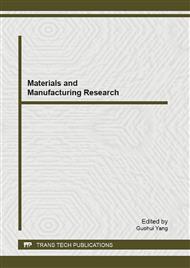p.3
p.8
p.13
p.19
p.25
p.30
p.34
p.38
Effect of Carboxymethylcellulose on Plasticized Polylactide
Abstract:
Polylactide (PLA) was plasticized by two types of plasticizers, glycerol and triacetin. These plasticized PLA were mixed with carboxymethylcellulose (CMC). It was found that with only small amount of CMC, 4.5 wt%, it is effectively to lower glass transition, cold crystallization and melting temperatures of glycerol-plasticized PLA (PLA-g) but not much affected on tensile properties. Moreover, increasing amount of CMC twice could not much affect thermal properties but largely reduced tensile strength, modulus and elongation. The melt flow index of the PLA-g increased largely with the amount of CMC. When 4.5 wt% CMC was added to the glycerol-triacetin plasticized PLA, only glass transition temperature became lower than that of 4.5 wt% CMC filled PLA-g but melting temperature and crystallinity were rather increased with poorer mechanical properties. Increasing amount of CMC tended to enhance melting temperature but still rather poor mechanical properties and high melt flow index. So, the CMC had strong positive effect on melt and negative effect on solid properties of plasticized PLA.
Info:
Periodical:
Pages:
19-24
Citation:
Online since:
January 2013
Authors:
Price:
Сopyright:
© 2013 Trans Tech Publications Ltd. All Rights Reserved
Share:
Citation:


